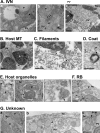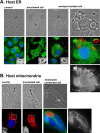Hostile intruder: Toxoplasma holds host organelles captive
- PMID: 29596535
- PMCID: PMC5875880
- DOI: 10.1371/journal.ppat.1006893
Hostile intruder: Toxoplasma holds host organelles captive
Erratum in
-
Correction: Hostile intruder: Toxoplasma holds host organelles captive.PLoS Pathog. 2018 Apr 24;14(4):e1007018. doi: 10.1371/journal.ppat.1007018. eCollection 2018 Apr. PLoS Pathog. 2018. PMID: 29689101 Free PMC article.
Conflict of interest statement
The authors have declared that no competing interests exist.
Figures


Similar articles
-
[Toxoplasma gondii--intracellular parasite].Wiad Parazytol. 2002;48(1):23-8. Wiad Parazytol. 2002. PMID: 16883700 Review. Polish.
-
The triumvirate of signaling molecules controlling Toxoplasma microneme exocytosis: Cyclic GMP, calcium, and phosphatidic acid.PLoS Pathog. 2019 May 23;15(5):e1007670. doi: 10.1371/journal.ppat.1007670. eCollection 2019 May. PLoS Pathog. 2019. PMID: 31121005 Free PMC article.
-
Have it your way: how polymorphic, injected kinases and pseudokinases enable Toxoplasma to subvert host defenses.PLoS Pathog. 2013;9(4):e1003296. doi: 10.1371/journal.ppat.1003296. Epub 2013 Apr 25. PLoS Pathog. 2013. PMID: 23633947 Free PMC article. No abstract available.
-
Rhoptries are major players in Toxoplasma gondii invasion and host cell interaction.Cell Microbiol. 2007 Apr;9(4):841-8. doi: 10.1111/j.1462-5822.2007.00909.x. Epub 2007 Mar 8. Cell Microbiol. 2007. PMID: 17346309 Review.
-
Role of secretory dense granule organelles in the pathogenesis of toxoplasmosis.Curr Top Microbiol Immunol. 1996;219:59-65. doi: 10.1007/978-3-642-51014-4_6. Curr Top Microbiol Immunol. 1996. PMID: 8791689 Review. No abstract available.
Cited by
-
Selective host autophagy is induced during the intracellular parasite Toxoplasma gondii infection controlling amino acid levels.mSphere. 2024 Jul 30;9(7):e0036924. doi: 10.1128/msphere.00369-24. Epub 2024 Jul 9. mSphere. 2024. PMID: 38980070 Free PMC article.
-
Emerging Infectious Diseases and the Eye: Ophthalmic Manifestations, Pathogenesis, and One Health Perspectives.Int Ophthalmol Clin. 2024 Oct 1;64(4):39-54. doi: 10.1097/IIO.0000000000000539. Epub 2024 Oct 29. Int Ophthalmol Clin. 2024. PMID: 39480207 Free PMC article. Review.
-
Toxoplasma gondii inhibits the expression of autophagy-related genes through AKT-dependent inactivation of the transcription factor FOXO3a.mBio. 2023 Aug 31;14(4):e0079523. doi: 10.1128/mbio.00795-23. Epub 2023 Jun 30. mBio. 2023. PMID: 37387601 Free PMC article.
-
Toxoplasma-host endoplasmic reticulum interaction: How T. gondii activates unfolded protein response and modulates immune response.Curr Res Microb Sci. 2024 Feb 1;6:100223. doi: 10.1016/j.crmicr.2024.100223. eCollection 2024. Curr Res Microb Sci. 2024. PMID: 38352129 Free PMC article. Review.
-
The pathogenicity and virulence of Toxoplasma gondii.Virulence. 2021 Dec;12(1):3095-3114. doi: 10.1080/21505594.2021.2012346. Virulence. 2021. PMID: 34895084 Free PMC article.
References
-
- Sibley LD, Niesman IR, Parmley SF, Cesbron-Delauw MF. Regulated secretion of multi-lamellar vesicles leads to formation of a tubulo-vesicular network in host-cell vacuoles occupied by Toxoplasma gondii. J Cell Sci. 1995;108 (Pt 4): 1669–1677. - PubMed
-
- Magno RC, Lemgruber L, Vommaro RC, De Souza W, Attias M. Intravacuolar network may act as a mechanical support for Toxoplasma gondii inside the parasitophorous vacuole. Microsc Res Tech. 2005;67: 45–52. doi: 10.1002/jemt.20182 - DOI - PubMed
-
- De Souza W, Attias M. New views of the Toxoplasma gondii parasitophorous vacuole as revealed by Helium Ion Microscopy (HIM). J Struct Biol. 2015;191: 76–85. doi: 10.1016/j.jsb.2015.05.003 - DOI - PubMed
-
- Mercier C, Dubremetz J-F, Rauscher B, Lecordier L, Sibley LD, Cesbron-Delauw M-F. Biogenesis of nanotubular network in Toxoplasma parasitophorous vacuole induced by parasite proteins. Mol Biol Cell. 2002;13: 2397–2409. doi: 10.1091/mbc.E02-01-0021 - DOI - PMC - PubMed
-
- Caffaro CE, Boothroyd JC. Evidence for host cells as the major contributor of lipids in the intravacuolar network of Toxoplasma-infected cells. Eukaryotic Cell. 2011;10: 1095–1099. doi: 10.1128/EC.00002-11 - DOI - PMC - PubMed
Publication types
MeSH terms
Substances
Grants and funding
LinkOut - more resources
Full Text Sources
Other Literature Sources
Medical

